4 Water Meter Types and Common Water Measurement Devices
Conventional water measurement devices include positive displacement meters and velocity flow meters, while non-mechanical designs (electromagnetic and ultrasonic meters) are less common water meter types.
What is the difference between a water meter and a water flow meter?
A water meter measures the quantity or volume of water that passes through a pipe or meter. The standard measurements are in gallons or cubic feet. The water meter may also provide totalized flow (the cumulative volume of water passing through the meter).
A water flow meter measures the speed or flow rate of water passing through but also may provide different characteristics of the liquid, such as:
- Flow rate
- Quantity
- pH
- Quality
- Electric conductivity
A water flow meter may also calculate water bills or indicate the quantity of liquid needed to add to a process.
What are the four most common water meter types?
The most common types of water meters are mechanical (positive displacement and velocity meters), while non-mechanical designs (electromagnetic and ultrasonic meters) are less common.
#1 Positive Displacement Meters
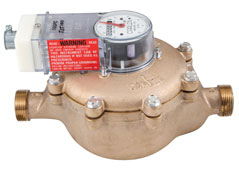
The Carlon JSJ water meter is a positive displacement meter.
The positive displacement meter (PD meter) is a standard residential and small commercial water meter. It is the most common type and generally very accurate at the low-to-medium flow rates typical in these applications and ranges typically from 5/8″-2″. Water usually displaces a moving measuring element in this meter type, which is directly proportional to the volume of water passing through the meter. The movement directs a magnet that drives the register.
These meters have moving parts, meaning there will be some maintenance and repair costs with maintaining the meters.
#2 Velocity Flow Meter
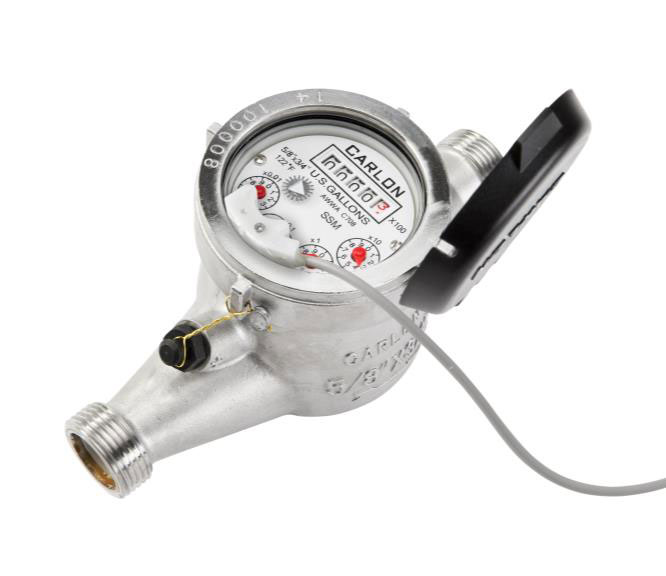
Carlon SSMR with digital remote counter is a multi-jet meter.
A velocity meter measures water flow velocity through the device with an understood internal capacity. The flow speed is converted to a volume of flow to determine consumption. There are three different types of velocity meters:
Single and Multi-jet Meters
This style of water meter has a blade rotated by water jets at a known speed. An internal strainer prevents the jets from clogging. This type of meter is effective at low water flow and small diameters. It is used primarily in domestic secondary billing, water monitoring, batch control, and small industrial applications.
The single jet style is low-cost, simple, and appropriate for submetering applications. A single port creates a jet stream of water with a single direct impact, rotating the turbine and transmitting the motion to a display mechanism that measures the passing volume.
Similarly, the multi-jet meters have multiple ports, each creating a jet of water that hits an impeller surrounding an internal chamber. Multi-jet meters retain accuracy at lower flow rates. They are ideal for large water users and industrial water installations. They record real-time data and, therefore, can convey changes in water consumption.
Turbine Flow Meters
The turbine-style meter is appropriate in low flow conditions with high volume in large-diameter pipes, such as in industrial or commercial settings. The meter has blades on an internal rotor angled to rotate with the water flowing through it. Magnets are used to measure the speed of the blades’ rotation, and no matter which direction the turbine turns, clockwise or counterclockwise, the meters are accurate.
Compound Water Meters
Compound water meters combine positive displacement and turbine technologies to deliver accurate measurements in applications that experience rapid and wide fluctuations in water demand. The meters are appropriate for hospitals, universities, large residential complexes, manufacturing, and processing.
#3 Electromagnetic (Mag Meters)
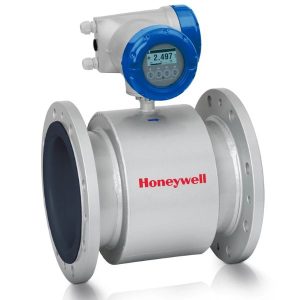 The magnetic (mag meter) or electromagnetic water meter is optimum for water and wastewater applications and offers long-term reliability and stability. Magmeters have no moving parts, require minimal maintenance, have low repair costs, and measure volumetric flow with high accuracy.
The magnetic (mag meter) or electromagnetic water meter is optimum for water and wastewater applications and offers long-term reliability and stability. Magmeters have no moving parts, require minimal maintenance, have low repair costs, and measure volumetric flow with high accuracy.
Electromagnetic flow meters have a transmitter and sensor that work together to measure flow. The sensor is placed inline and measures an induced voltage generated by the fluid as it flows through a pipe. The transmitter converts the voltage the sensor generates into a flow measurement and transmits that to a control system.
Honeywell VersaFlow Mag 1000 is for water and wastewater applications. The model’s long-term reliability and durability make it the standard flow sensor for the water market.
#4 Ultrasonic Water Meters
Ultrasonic water meters use ultrasound to measure the speed of the fluid. There are two distinct ultrasonic meters – transit time and Doppler.
Transit-Style Ultrasonic Meter
Transit-style ultrasonic meters are accurate in low flow conditions, have no moving parts, and have a long life. They provide real-time data. They are preferred when installing in retrofit situations where space is limited because the meter can be installed in different positions. The downside of the meter type is that they are more expensive upfront than some alternatives.
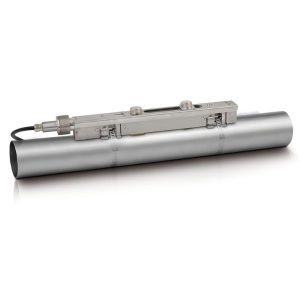 The Honeywell VersaFlow Ultrasonic is a clamp-on-style meter installed on the outside of a process pipe. It uses transit-time technology and is ideal for clean liquid applications. It reduces installation downtime and provides significant cost-effectiveness compared to inline flow measurement equipment, especially in larger pipe sizes.
The Honeywell VersaFlow Ultrasonic is a clamp-on-style meter installed on the outside of a process pipe. It uses transit-time technology and is ideal for clean liquid applications. It reduces installation downtime and provides significant cost-effectiveness compared to inline flow measurement equipment, especially in larger pipe sizes.
Doppler-Style Ultrasonic Meter
Doppler-style ultrasonic flow meters use wrap-around sensors installed outside the pipe. They are simple, inexpensive, and used in the mining industry, sewage, or applications where solids are present. The Doppler-ultrasonic meter is not as accurate for clean liquids.
Are you in need of water measurement devices?
Residential Water Meters & Industrial Flow Meters
We represent Carlon residential water meters, industrial water flow meters, Honeywell clamp-on ultrasonic meters, and VersaFlow electromagnetic meters.
-
[…] of water charge that is assessed by water utilities. They are typically based on the size of the water meter and the amount of water that is used. Tap charges can also be based on the type of water service, […]
Leave a Comment
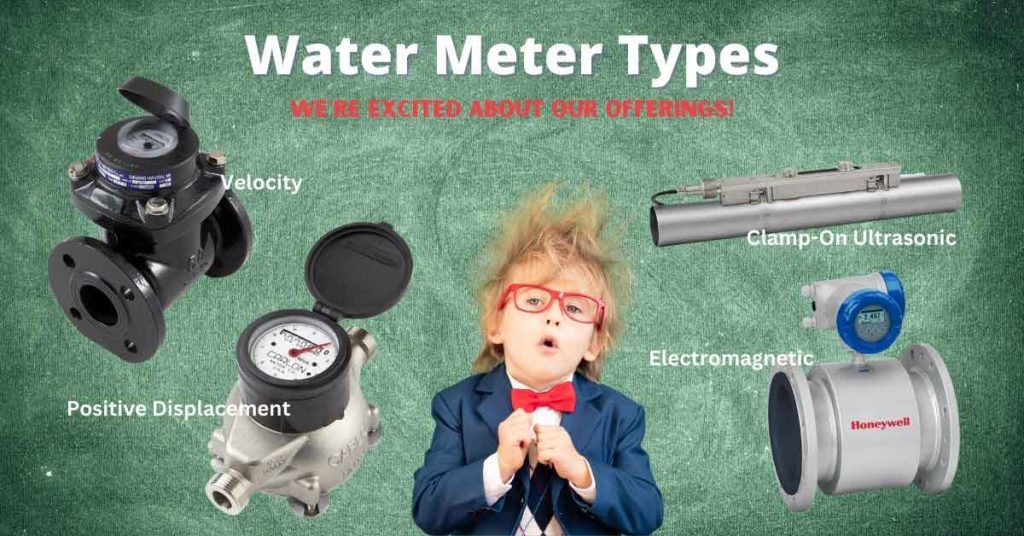
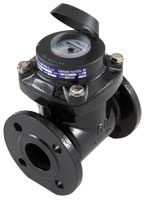

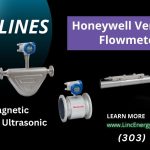
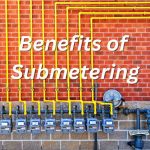
Nice Blog!! The content you have shared is very elaborative and informative. Thanks a lot for sharing such a great piece of knowledge with us.
The water consumption trends and reports help you better understand your consumption and bring changes for better utilization of water.mablei water meters measure water using ultrasonic sensors, so there is no wear and tear as in mechanical meters. The smart electronic circuits take the meter readings and upload the data without manual intervention
Comprehensive blog I learnt a lot as I contemplate to setup a water meter assembly plant in Uganda
Interesting there is no mention of Ultrasonic meters?? All your PD meters are referred to as highly accurate…..Are you saying Ultrasonic is NOT more accurate than PD or Nutating Disc??
Yes, ultrasonics are mentioned above. They are less common. They are more expensive and accurate in clean water.